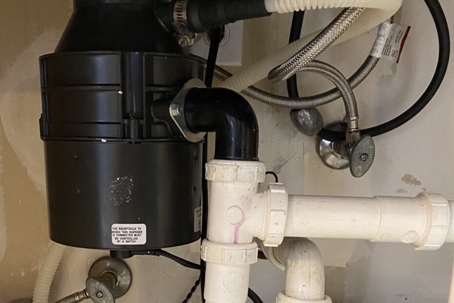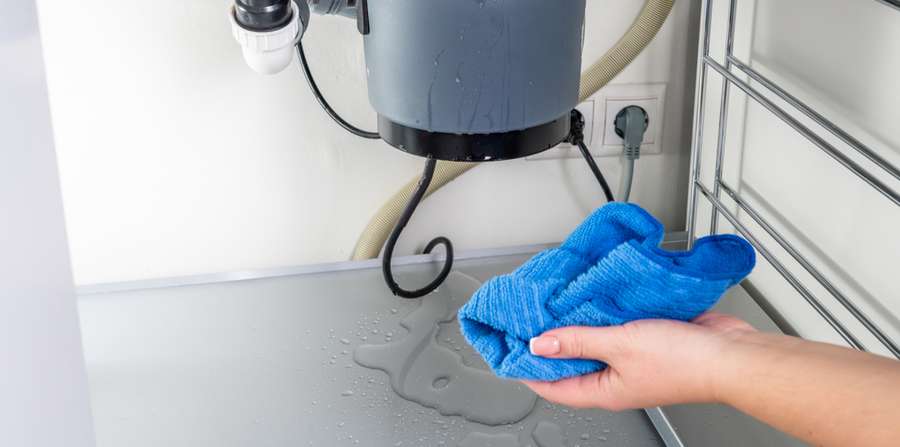Easy Ways to Repair a Leaky Waste Disposal Unit
Easy Ways to Repair a Leaky Waste Disposal Unit
Blog Article
We've discovered this post about The Handy Guide To Fixing Your Garbage Disposal Leaking below on the net and reckoned it made sense to write about it with you in this article.

Garbage disposals are necessary kitchen area home appliances that aid in throwing away food waste successfully. However, a leaking garbage disposal can be an aggravating and untidy issue to take care of. The good news is, several leakages can be dealt with easily with a couple of easy actions. In this short article, we will certainly go over just how to take care of a leaking waste disposal unit properly.
Introduction
Garbage disposals are installed under cooking area sinks and are made to shred food waste right into smaller pieces, permitting it to pass through the pipes system conveniently. While these devices are normally reliable, leaks can take place with time because of deterioration, loose links, or damage to the device.
Usual Root Causes Of Leakages in Trash Disposals
Worn Seals and Gaskets
Seals and gaskets play an important duty in preventing water from dripping out of the garbage disposal. Over time, these parts can weaken, leading to leakages around the disposal device.
Loose Connections
The links in between the garbage disposal and the plumbing system can come to be loosened with time, creating water to leakage out during procedure.
Fractures or Holes in the Disposal Device
Physical damage to the waste disposal unit, such as fractures or openings in the housing, can additionally lead to leaks.
Determining the Resource of the Leak
Prior to trying to deal with a dripping garbage disposal, it is necessary to determine the source of the leakage. This can normally be done via aesthetic examination or by carrying out simple tests.
Visual Assessment
Inspect the garbage disposal system very carefully for any indications of water leakage. Pay attention to areas around seals, gaskets, and connection factors.
Checking for Leakages
One means to examine for leakages is by running water via the disposal system and checking for any type of visible signs of leakage.
Devices and Materials Needed for Fixing a Dripping Waste Disposal Unit
Before starting the repair service process, gather the essential tools and products, including a screwdriver, flexible wrench, plumbing technician's putty, replacement seals or gaskets, and epoxy or patching material for fixing cracks or holes.
Step-by-Step Guide to Taking Care Of a Dripping Waste Disposal Unit
Shut off the Power
Prior to attempting any type of repair services, make certain that the power to the waste disposal unit device is turned off to avoid the danger of electric shock.
Situate the Leak
Recognize the precise place of the leakage and establish the cause.
Tighten Connections
Make use of a wrench to tighten any type of loose links in between the disposal unit and the plumbing system.
Change Seals or Gaskets
If the leak results from used seals or gaskets, eliminate the old components and replace them with new ones.
Patching Fractures or Openings
For splits or openings in the disposal unit, use epoxy or an appropriate patching product to secure the broken area.
Examining the Waste Disposal Unit After Repair Service
Once the repair work is full, test the garbage disposal by running water with it to make certain that the leakage has been fixed.
Preventive Upkeep Tips to Stay Clear Of Future Leakages
To stop future leakages, it is essential to perform routine maintenance on your garbage disposal. This includes keeping it tidy, staying clear of placing non-food items or difficult objects down the disposal, and regularly checking for leaks or various other concerns.
Final thought
In conclusion, repairing a dripping waste disposal unit is a relatively uncomplicated process that can be finished with fundamental tools and products. By following the actions described in this article and practicing preventive upkeep, you can keep your garbage disposal in good working problem and prevent pricey repairs in the future.
What to Do About a Leaking Garbage Disposal
A leaking garbage disposal often goes unnoticed until you confront a sopping cabinet, a foul-smelling puddle, or an audible drip-drip-drip from the unit. The fix can be frustrating, too, because the leak can stem from a number of components in the system. Fortunately, with a little sleuthing, you can zero in on the leak and—depending on the exact location—stop the icky oozing and repair the component that caused it. Worst case scenario, if it turns out that the garbage disposal must be replaced, installing a new one is a reasonable do-it-yourself task for those with basic plumbing skills. Read on to keep the cash you’d otherwise hand over to a pro.
Prepare to find the leak
Prior to testing the garbage disposal for leaks, unplug it at the wall outlet and turn off the power from the breaker box to prevent electrical shock. Then insert a watertight sink stopper into your sink drain and wipe the unit dry with a clean cloth. In any handy container, mix a few drops of food coloring into a few cups of water, and pour the dyed water onto the sink stopper to help you locate the leak.
Investigate the source
the top, where the disposal meets the sink drain the side, where the dishwasher hose or main drain pipe connects to the disposal or the bottom of the unit Inspect each of these locations while gliding a light-colored rag over the unit; the dyed water will readily show on the rag and reveal the location of the leak. If a leak isn’t immediately apparent, remove the sink stopper and pour a few more cups of dyed water down the sink drain, then check for leaks again. Leaks near the top of the unit are more likely to show themselves while the sink is plugged, while side and bottom leaks are more noticeable while the sink is unplugged.
The metal sink flange that sits directly inside the sink drain is typically sealed around the top with plumber’s putty (a clay-like sealant) and then secured from under the sink with bolts. If the plumber’s putty deteriorates, or the bolts loosen, the flange can no longer form a watertight seal between the sink drain and the disposal—which could cause a leak at the top of the unit.
To reseal the leaky flange, you must first detach the garbage disposal. Start by loosening the screws securing the main drain pipe to the disposal, then loosen the screws in the metal clamp securing the dishwasher hose to the disposal and detach the drain pipe and dishwasher hose from the disposal. Loosen the screws in the mounting ring that connects the disposal to the metal mounting assembly beneath the sink, then pull down the disposal and carefully set it on a clean, dry surface. Loosen the bolts in the mounting assembly with a wrench, then pull down the mounting assembly and set it near the disposal.

Hopefully you enjoyed our part about Garbage Disposal Leaking From Bottom. Thank you for spending some time to browse our piece of content. Sharing is nice. One never knows, you may be doing someone a favor. Thank you so much for your time invested reading it.
Schedule An Appointment Report this page